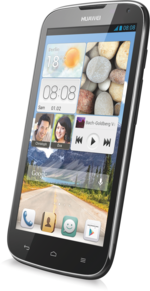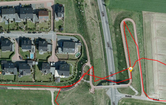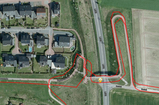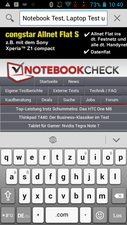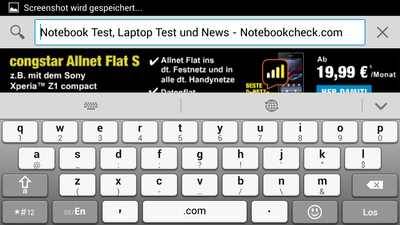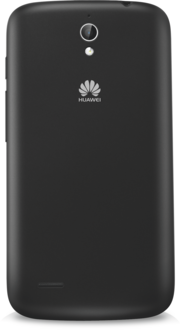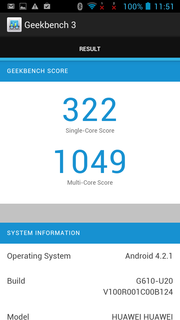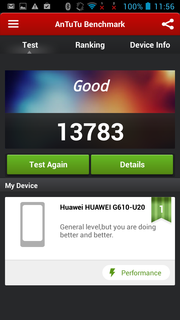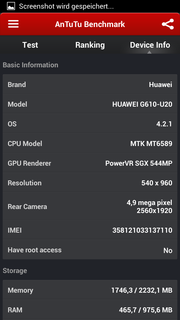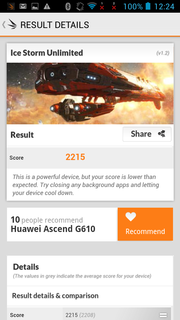Review Huawei Ascend G610 Smartphone

For the original German review, see here.
Product diversification is an important topic for many manufacturers. Samsung, for instance, offers devices for almost all product categories, and the aspiring Chinese manufacturer Huawei continues to expand its smartphone range as well. We lost track of the designation scheme a long time ago. Sure, the Y-series represents the entry-level segment, whereas the G-series is more mainstream. We are pretty sure that the numbers are supposed to mean something, but why is the Ascend G615, the successor of the Ascend G600, followed by the review unit G610 a couple of months later? We don't understand it, but it is not really important anyway.
According to the manufacturer, the Huawei Ascend G610 is an appealing dual-SIM smartphone. Sounds nice, but that does not really tell us anything. So here are the important specifications: 5-inch display with qHD resolution, 1.2 GHz quad-core provided by MediaTek, 1 GB memory, 4 GB flash storage and a 5 MP camera – and obviously the dual-SIM feature. The whole package is available for 199 Euros (~$273) – therefore lower mainstream. Some popular online shops already list the Ascend G610 for around 180 Euros (~$247). There is a lot of competition in this price segment, for instance the price-performance champion Motorola Moto G or the French Wiko Stairway. Another alternative would be the LG L90.
Case
This lower mainstream impression continues when you hold the Huawei Ascend G610. It is not really light with 170 grams. The rubberized plastic surface of the battery cover does not feel really good but ensures a good grip. The build quality is actually pretty convincing, although it requires some force if you want to open or close the battery cover. You can describe the design of the G610 with one word: boring. However, this is not necessarily a bad thing. At least you're not getting bored by some color spots or design elements.
The stability of the G610 does not cause any criticism; it requires a lot of force to twist it. Huawei's smartphone certainly benefits from the not very thin silhouette with a height of 9.9 millimeters. Length and width are typical for this smartphone class.
Connectivity
You can actually expect decent hardware equipment for a price of 200 Euros (~$275) nowadays, and the Huawei Ascend G610 does not disappoint for the most part. Heart of the smartphone is a quad-core processor from the manufacturer MediaTek, which is known for inexpensive components. The Cortex-A7 cores of the MT6589 are clocked at 1.2 GHz and supported by a PowerVR SGX544. This is not the latest GPU but works well for this product class, and the same applies for the 1 GB memory. Huawei saved some money in terms of internal storage and only integrated 4 GB, but you can expand it via micro SD card (up to 32 GB). There are no surprises when you look at the ports and the control elements. The USB 2.0 port at the bottom can also be used to recharge the smartphone. Volume rocker and power button are on the right side of the case. The Android controls are touch buttons underneath the display and do not occupy space on the screen.
Software
Google Android Jelly Bean version 4.2.1 – this is the full designation of the operating system. Android 4.2 is not really up to date anymore; Google and other manufacturers already ship devices with 4.4 KitKat. According to the manufacturer, there will be no update to Android 4.3 or even 4.4 anytime soon. Huawei uses its customized Emotion UI in version 1.6, and the simple handling works well with the entry-level orientation of the smartphone.
Communication & GPS
We can cover this section pretty quickly. Both SIM slots of the Huawei Ascend G610 support triple-band GSM (900, 1800, 1900 MHz). Dual-band UMTS (900 and 2100 MHz) only works with SIM slot number one. The theoretical transfer rates of HSPA+ are 21 Mbps (download) and 5.76 Mbps (upload), respectively. The WLAN module supports the standards 802.11 b/g/n, but only in 2.4 GHz networks. The range of the module is very satisfying and Bluetooth 4.0 is also up to date.
The GPS module works reliably and even gets a good signal indoors within a couple of seconds. A practical test on an 11-kilometer-long bicycle ride supports the good impression; the recorded track usually corresponds with the real track. Compared to the Garmin Edge we can only see a small deviation of the sensor inside the G610.
Telephone Functions and Voice Quality
Managing the two SIM slots is well-integrated into the system; you can assign calls as well as text messages to the individual cards. Data transfers via 3G are only supported by SIM slot 1. Both slots can also be deactivated individually. You will have to remove the battery before you can insert or remove the two Mini-SIM cards,
The phone app is very simple, and inputs work really well thanks to the large number keys. Not really perfect is the voice quality. Callers sound a bit tinny, but they are still easy to understand. Our voice sounds slightly synthetic and distorted, background noises are hardly suppressed.
Cameras & Multimedia
Two cameras are integrated into the Huawei Ascend G610, but that is not really spectacular. The 0.3 MP sensor at the front should only be used for video chats at best, the resolution is just not sufficient for usable pictures. The main camera has a much higher resolution with 5 MP and takes decent pictures. Colors are strong and the contrast is high, even darker areas are visible. Still, we miss a bit of sharpness, especially in the background. A solid performance nonetheless.
Accessories
You can get the Huawei Ascend G610 in the colors black or white. The box contains a removable battery, a power adaptor, a USB cable, a stereo headset and a quick-start guide. We are pretty sure that there will be optional accessories in Huawei's online shop, for example, battery covers, batteries or device covers; but there are no products at the moment.
Warranty
The warranty period is two years, but the battery is only covered for six months. There are no optional warranty extensions or service upgrades.
Input Devices & Handling
A 5-inch touchscreen is the main input device of the Huawei Ascend G610. It provides accurate and reliable controls over the whole surface and the peripheral zones as well. The glass surface could be a tad smoother for our taste; our fingers got stuck on the display a couple of times. We can also determine a slight delay before the touchscreen executes inputs.
Huawei's Emotion UI also has its own keyboard layout, which has advantages and disadvantages compared to the stock Android version. You can enter numbers when you hold down the keys in the first row, and the space bar is assigned with ".com" in the browser; a smiley button is available as well. You can also switch between the German and the English keyboard layout. Unfortunately, the system does not save the setting and you will have to change it every time. The feedback of the keyboard benefits from key clicks and vibration.
Display
Many manufacturers use the display to save some money in this lower-price range. This is pretty much a no-go for a smartphone. Huawei, fortunately, equips the Ascend G610 with an IPS display, so we should expect good colors and wide viewing angles. The display measures 5-inches, which is pretty much the standard size for smartphones now. A resolution of 960x540 pixels corresponds with the price range, even though rivals like the Motorola Moto G or the Wiko Stairway feature the HD resolution. Still, the display content does not appear blurry, and you can only see individual pixels when you look very closely – for example, at zoomed texts.
Our measurement results are neither very good nor very bad. A brightness of around 300 nits is average, and the same applies for the brightness distribution of 88%. The rivals Moto G and Wiko Stairway are clearly superior. Huawei's smartphone offers a better contrast of 640:1 in return, primarily thanks to the black value of 0.47 cd/m².
| |||||||||||||||||||||||||
Brightness Distribution: 88 %
Center on Battery: 301 cd/m²
Contrast: 640:1 (Black: 0.47 cd/m²)
ΔE ColorChecker Calman: 4.61 | ∀{0.5-29.43 Ø4.78}
ΔE Greyscale Calman: 6.4 | ∀{0.09-98 Ø5}
Gamma: 2.56
CCT: 6923 K
Subjectively, the display leaves a good impression, but it could be brighter. Colors are rich and natural, and the contrast is decent.
We use the colorimeter X-Rite i1Pro2 in combination with the CalMAN software for objective results. We can see that brighter shades of gray show a larger deviation from the sRGB reference in particular. You can see a green cast with the human eye, and the color temperature is slightly too cool. The presentation of primary colors is much better, and we can only see a bigger deviation of yellow in the saturation sweeps of the Huawei Ascend G610. An average ColorChecker DeltaE deviation of 4.61 is not bad – especially when you consider the price.
The average luminance already suggested it: The display of the Huawei G610 is not perfect outdoors, but a place in the shade helps a lot. However, we can hardly criticize the viewing-angle stability. As expected for an IPS display, it is very good. But we can also see the typical glow effect when we look from the bottom left.
Performance
Nobody is going to expect any performance miracles from a smartphone for 200 Euros (~$275). However, other reviews showed that you should expect a decent level of performance. Our comparison group primarily consist of lower mainstream devices, but we also use the Motorola Moto G, which has been available for quite some time now, because of the great price-performance ratio.
The Huawei Ascend G610 does not set any new records with its 1.2 GHz quad-core processor, but our tests show that it offers sufficient performance for almost every task. Even current games are enjoyable on the 5-inch device, not least because of the precise touchscreen and position sensor. Very demanding games, however, only run smoothly in the lowest settings.
The web-browsing performance is average and can hardly compete with the other devices from our comparison group. AndroBench also determines pretty low results for the internal storage.
| Geekbench 3 | |
| 32 Bit Single-Core Score (sort by value) | |
| Huawei Ascend G610 | |
| Motorola Moto G 1. Gen XT1032 | |
| LG L90 | |
| Wiko Stairway | |
| Google Nexus 5 | |
| 32 Bit Multi-Core Score (sort by value) | |
| Huawei Ascend G610 | |
| Motorola Moto G 1. Gen XT1032 | |
| LG L90 | |
| Wiko Stairway | |
| Google Nexus 5 | |
| AnTuTu v4 - Total Score (sort by value) | |
| Huawei Ascend G610 | |
| Motorola Moto G 1. Gen XT1032 | |
| LG L90 | |
| Google Nexus 5 | |
| PassMark PerformanceTest Mobile V1 - System (sort by value) | |
| Huawei Ascend G610 | |
| Motorola Moto G 1. Gen XT1032 | |
| LG L90 | |
| Google Nexus 5 | |
| GFXBench (DX / GLBenchmark) 2.7 | |
| T-Rex Onscreen (sort by value) | |
| Huawei Ascend G610 | |
| Motorola Moto G 1. Gen XT1032 | |
| LG L90 | |
| Google Nexus 5 | |
| 1920x1080 T-Rex Offscreen (sort by value) | |
| Huawei Ascend G610 | |
| Motorola Moto G 1. Gen XT1032 | |
| LG L90 | |
| Google Nexus 5 | |
| 3DMark | |
| 1920x1080 Ice Storm Extreme Score (sort by value) | |
| Huawei Ascend G610 | |
| Motorola Moto G 1. Gen XT1032 | |
| LG L90 | |
| Wiko Stairway | |
| 1280x720 offscreen Ice Storm Unlimited Score (sort by value) | |
| Huawei Ascend G610 | |
| Motorola Moto G 1. Gen XT1032 | |
| Google Nexus 5 | |
| Mozilla Kraken 1.1 - Total (sort by value) | |
| LG L90 | |
| Wiko Stairway | |
| Google Nexus 5 | |
| Octane V2 - Total Score (sort by value) | |
| Huawei Ascend G610 | |
| LG L90 | |
| Wiko Stairway | |
| Google Nexus 5 | |
| Google Nexus 5 | |
| Sunspider - 1.0 Total Score (sort by value) | |
| Huawei Ascend G610 | |
| Motorola Moto G 1. Gen XT1032 | |
| LG L90 | |
| Wiko Stairway | |
| Google Nexus 5 | |
| Google Nexus 5 | |
| Peacekeeper - --- (sort by value) | |
| Huawei Ascend G610 | |
| Motorola Moto G 1. Gen XT1032 | |
| LG L90 | |
| Wiko Stairway | |
| Google Nexus 5 | |
| AndroBench 3-5 | |
| Sequential Read 256KB (sort by value) | |
| Huawei Ascend G610 | |
| Motorola Moto G 1. Gen XT1032 | |
| LG L90 | |
| Wiko Stairway | |
| Google Nexus 5 | |
| Sequential Write 256KB (sort by value) | |
| Huawei Ascend G610 | |
| Motorola Moto G 1. Gen XT1032 | |
| LG L90 | |
| Wiko Stairway | |
| Google Nexus 5 | |
| Random Read 4KB (sort by value) | |
| Huawei Ascend G610 | |
| Motorola Moto G 1. Gen XT1032 | |
| LG L90 | |
| Wiko Stairway | |
| Google Nexus 5 | |
| Random Write 4KB (sort by value) | |
| Huawei Ascend G610 | |
| Motorola Moto G 1. Gen XT1032 | |
| LG L90 | |
| Wiko Stairway | |
| Google Nexus 5 | |
* ... smaller is better
Emissions
Temperature
Smartphones and tablets with very powerful processors often have issues with the temperature development. This is, however, no problem for the Huawei Ascend G610: The low clocked quad-core processor does not seem to produce a lot of heat, and the case also has a lot of space to dissipate it. In short: The 5-inch device does not even get lukewarm under any kind of load. Quite the contrary actually, not many smartphones remain this cool. The power adaptor does not get really warm, either, even under continuous load.
(+) The maximum temperature on the upper side is 33.2 °C / 92 F, compared to the average of 35.2 °C / 95 F, ranging from 21.9 to 247 °C for the class Smartphone.
(+) The bottom heats up to a maximum of 33.7 °C / 93 F, compared to the average of 34 °C / 93 F
(+) In idle usage, the average temperature for the upper side is 27.2 °C / 81 F, compared to the device average of 32.9 °C / 91 F.
Speakers
A single speaker at the lower left corner of the back – your expectations should not be too high. The small speaker only manages a low maximum volume, although this might be an advantage when you consider the tinny sound. High tones are distorted and definitely not a pleasure for the ears. Bass? Not available. Fortunately, the stereo jack leaves a better impression. You should definitely use headphones for calls or music playback, but the sound is still sufficient for games.
Energy Management
Power Consumption
8.2 Wh is provided by the removable lithium-polymer battery. This is not bad, but the Huawei Ascend G610 is not a really frugal device. The 5-inch smartphone already consumes 0.5 Watts during standby, a phenomenon that we often see with MediaTek processors. Rivals like the LG G90 and Motorola Moto G also consume less during idle. The G610 is only comparatively frugal under maximum load, so let's look at the battery runtimes.
| Off / Standby | |
| Idle | |
| Load |
|
Key:
min: | |
Battery Runtime
Our runtime measurements support the low consumption of the Ascend G610 under maximum load. The battery manages almost four hours – a great result and almost on a level with the LG L90 and Motorola G. However, the G610 consumes more power than the rivals in more practical scenarios, which affects the battery runtimes as well. Our WLAN test with an adjusted brightness of 150 cd/m² only resulted in around eight-and-a-half hours for the 5-inch smartphone. An average result at best.
Verdict
It was unlikely that we would praise an inexpensive mainstream smartphone too much. However, we did not expect such a good performance from the Huawei Ascend G610 for around 200 Euros (~$275). Sure, the dual-SIM smartphone is not a great success, but it is solid and does not reveal any serious drawbacks – and these are the important virtues for this highly competitive mainstream market. But one thing at a time.
Most users would say that the Huawei Ascend G610 is a pretty boring smartphone in terms of design, but the case offers an impeccable build quality and high stability in return. It is, however, not very convenient in the hands. The performance easily meets the demands of this price range, and that applies to the display and the resolution as well – even though Motorola and Wiko try to attract the attention of customers with HD displays. The good viewing-angle stability cannot compensate for the mediocre luminance.
The G610 actually takes pretty good pictures, at least if you avoid the bad camera at the front. Bad is also the correct term for the speaker, you basically have to use headphones. Huawei knows that and provides a stereo headset. The hands-free feature is also affected by the speaker. Overall, the voice quality during calls is still okay.
The same applies for the battery runtimes; they are pretty far away from great results. This does not, however, change the positive overall impression of the Huawei Ascend G610. For 200 Euros (~$275) you get a solid, yet visually very "normal" smartphone with a dual-SIM and a 5-inch display. Definitely worth considering.




